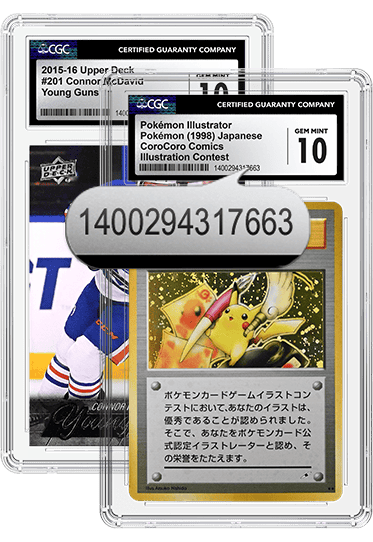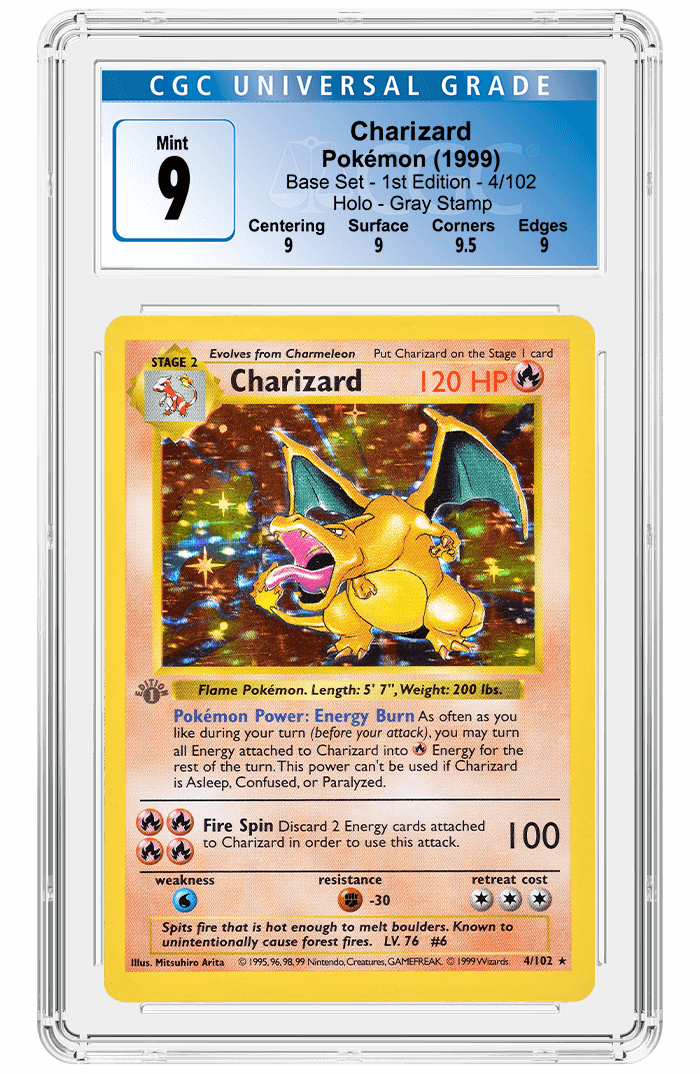A Pokémon TCG Myth No More: CGC Cards Certifies Two Prerelease Raichu
Posted on 01/11/2023
By
Paul Sandler
Director of Product Development
CGC Cards™ is thrilled to announce that it has authenticated and graded a pair of the most enigmatic cards in the entire Pokémon TCG: the Prerelease Raichu.
No third-party certification company has verified the authenticity of these once-mythical cards until now. However, using advanced multi-spectral imaging techniques and XRF scanning, as well as taking a deep dive into the provenance and history of their creation, CGC Cards now confirms that the Prerelease Raichu is very much a reality and that there are at least two genuine examples!
The History of Prerelease Raichu
Long believed to be a rumor or a myth, the Base Set Prerelease Raichu has sparked countless debates among collectors and fans for more than two decades. In fact, the first reference to one of these cards that the CGC Cards graders could locate online — still in its original form — was this blurb from a Pojo.com article, last updated on May 2, 2002!
 |
An even earlier account by "Edo," a contributor to the online forum PokeGym, explains that the card was first seen publicly at the 1999 Pokémon Tropical Mega Battle tournament. The event was held at the Hilton Hawaiian Village in Honolulu, Hawaii, from August 24-27, 1999. There, Edo witnessed a Wizards of the Coast (WotC) manager showing off an example of the card to an employee of Media Factory, the company that prints Pokémon TCG cards in Japan:
"Andrew Finch came out again and showed that same guy from Media Factory a special misprint card. 'Only 11 exist,' he said. Many know that there was a Clefable that was released that had a special green "PRERELEASE" stamp in the lower-right corner of the picture. However, it seems that there were 11 Base Set Raichus in with the Clefable mix, so they were stamped as well."
Below is an image of an example of the uncut sheet from which CGC Cards believes the Prerelease Raichu originated. Note the Clefable and Raichu cards in the top-left corner of the sheet. The remaining cards appear to be destined for Base Set theme decks.
While CGC Cards cannot prove that only 11 of these cards were created, it seems that the Prerelease Raichu cards were indeed accidentally stamped and then distributed to WotC employees as keepsakes without regard to any possible value they may hold. Mike Boozer, former Customer Service Manager at WotC, confirmed to CGC Cards that he is of the opinion that the above uncut sheet layout was the source of the famed Prerelease Raichu:
"Yes, that is exactly what I believe happened... I don't think anyone knew they would become valuable."
Other consultants have explained that cards given these Prerelease stamps were stamped on the uncut sheets before the sheets were cut. Typically, all of the cards on an uncut sheet are stamped at one time using as many foil dies as required. Since only the Clefable card on these sheets was to be stamped, it's likely that this may have been a test run. It's probable that the operator of the hot stamping machine simply loaded two dies into the machine instead of one, which stamped some Raichu cards along with the Clefables before the mistake was noticed.
To add additional credit to this story, both of these Prerelease Raichu cards were submitted to CGC by David Persin — owner of the most-complete English Pokémon collection in the world — who confirmed that they were obtained from former WotC employees.
"I chose to grade the cards through CGC Cards because of their reputation for employing both technical proficiency and solid evidentiary groundwork to ascertain whether cards are authentic or not," said David Persin. "No matter what the outcome was, I knew that the rationale behind those results would be fair and beyond reproach. I also appreciate how CGC Cards has evolved with the hobby as more of these truly unique cards have been revealed."
Two Mythical Journeys
Card #1 – Graded CGC 5.5
An image of the first Prerelease Raichu submission was first revealed on PokeGym.net in 2006, in honor of its 7th anniversary. The image was posted by Mike Boozer himself. Unfortunately, PokeGym's anniversary just happened to land on April 1, 2006, so many believed the post was a joke, even though it was not.
The image in the original link is now broken or missing. However, utilizing Archive.org (also known as the Wayback Machine), CGC Cards was able to recover the long-lost photograph. Comparing the image and the submission shows that this submission is, in fact, the same card that was pictured in 2006! Note the position of the stars and the scratch below the Raichu art. They match perfectly with Card #1 submitted for grading.
 |
 |
| Prerelease Raichu #1 (left) and an image of the same card taken by Mike Boozer in 2006 (right). Click images to enlarge. |
|
After publicly acknowledging that the card existed in the 2006 post, a member of the PokeGym forum middle-manned a deal to sell the card for Mr. Boozer. Boozer was well-known to have shown the card off after hours at events, even while jokingly claiming it didn't exist.
CGC Cards spoke with Mr. Boozer about the card, and he confirmed that he had owned it, while also telling us this story:
"I wanted one as a curiosity to show the kids on the tours and tournaments," Boozer said. "I had a binder they would look through filled with rare and misprint cards."
 |
|
| Mike Boozer browsing PokeGym.net. Note the uncut Base Set sheet behind him! Click image to enlarge. |
|
Card #1 was initially sold to a PokeGym forum member named Will Gore. The card was then submitted by him to another third-party grading service, which refused to authenticate and grade it. Gore seemingly preferred to only have graded cards in his collection, so he ended up selling the Prerelease Raichu at his cost to David Persin in May of 2009, who has owned it ever since.
Card #2 – Graded CGC 8
While Andrew Finch had claimed that there were 11 Prerelease Raichu cards made in 1999, Mike Boozer's example was the only one to have ever been seen publicly until now. On November 6, 2018, another former WotC employee, Jennifer M., brought her old binder to her new job at the Pokémon Company International. One of her co-workers was the first to point out that she had a Prerelease Raichu; Jennifer was unaware of the significance of the card. After pulling it out of the binder, both Jennifer and the other employee noticed a Post-it note on the back of the sleeve:
 |
| Post-it note from the back of the Prerelease Raichu's sleeve, addressed from Freddi. |
CGC Cards received signed letters from Jennifer and two of her co-workers confirming the authenticity of the story. Jennifer goes on to explain that Freddi — a co-worker at WotC — had personally given the card to her as a memento. The card had remained undiscovered in her binder for nearly two decades, and once found, was eventually sold to Persin.
Authenticating Prerelease Raichu
Visual Analysis
While provenance is, of course, extremely important with rare and esoteric items like Prerelease Raichu, it is also prudent to examine the cards themselves to confirm their authenticity. In this case, the only defining factor that makes these Raichu cards special is the Prerelease stamp in the bottom right corner of the art box. Therefore, CGC Cards focused its examination on the stamps. The graders cross-referenced both Prerelease Raichu cards with a Prerelease Clefable.
 |
|
| A close-up image of the prerelease stamps on Prerelease Raichu #1 (top), Prerelease Raichu #2 (middle) and a Prerelease Clefable (bottom) under infrared side lighting.Click images to enlarge. | |
Infrared side lighting is extremely useful for seeing how the foil of the Prerelease stamp reacts to the infrared light, as well as for showing any alterations that may have been made to the card. The above images all show a stamp in the same dimensions, each of which react the same way to the lighting. These are great indicators of authenticity.
Next, CGC Cards took an even closer look at the surfaces of the stamps.
The photos above were shot at 42x magnification under specialized coaxial lighting and are meant to display the surface texture of the foil stamps themselves. All three cards display the same rippled surface texture imparted from the foil die stamps, which are applied with heat and pressure. Different dies, heat or pressure settings would cause the surfaces of the foil to appear differently. The fact that the stamps on both Raichu cards have the same surface qualities as the Clefable is a very good indicator that all three cards were made at the same facility using the same equipment.
XRF Analysis
In addition to a visual analysis, CGC Cards' forensic analysts also examined the chemical makeup of the foil stamps when compared to two genuine Prerelease Clefable cards. The company’s X-ray fluorescence (XRF) scanner uses X-ray technology to non-destructively excite the atoms of a sample, then measure the secondary X-rays omitted. The chart below displays the result for the scans of the four cards:
All four cards have very similar amounts of calcium, titanium, iron, copper and zinc within the substrate and foil. Raichu #1 (pink) and Clefable #1 (red) tracked almost on top of each other, with the same occurring for Raichu #2 (green) and Clefable #2 (blue). There are some slight differences among the cards, but all are within tolerance and there is a very clear pattern that they all follow. If any of the foil compositions were different, the lines would diverge in a significant manner.
Conclusion
After closely examining these two Prerelease Raichu cards, as well as comparing them to known genuine Prerelease Clefable cards, CGC Cards conclusively certifies that the Prerelease Raichu cards are genuine and stamped in the same method as Prerelease Clefables.
In addition, a deep dive into the provenance of these two Prerelease Raichu cards has traced them both back to their origins with members of the original Wizards of the Coast team. Mike Boozer has also confirmed CGC Cards' hypothesis regarding the origin of these extraordinary cards, including the sheet they almost certainly originated from, which proves that they were accidentally created. CGC Cards is happy to shed more light on the early history of Pokémon by putting this mystery to rest.
CGC Cards would like to thank Mike Boozer, Michael Martin and Tavis King for their time and expertise in assisting with the authentication and certification of these cards.
David Persin can be reached on Instagram at @dpersin1. He also co-hosts a weekly podcast, Koffee Talks, on the DJGigabyte YouTube channel.
Sources:
“Pokémon Trading Card Game U.S. Error Cards.” Pokemon - Card Prices - Card Price Guide for TCG, 2 May 2002, www.pojo.com/priceguide/usErrorCards.html.
“International Tropical Mega Battle 1999.” Pokumon, 18 Oct. 2023, pokumon.com/1999-tropical-mega-battle-super-secret-battle/.
Boozer, Mike. Martin, Michael. "History of Pokemon Part 2a - Prerelease Raichu." PokeGym.Net, 1 Apr. 2006, pokegym.net/community/index.php?threads/history-of-pokemon-part-2a-prerelease-raichu.32583/. Accessed 30 Oct. 2023.
"Uncut Sheets." Pokemuseum.Weebly.Com, 23 Jul. 2023, pokemuseum.weebly.com/uncut-sheets.html. Accessed 30 Oct. 2023.
"Internet Archive." Archive.Org, 1 Jan. 1996, archive.org/. Accessed 30 Oct. 2023.
Related Links:
Stay Informed
Want news like this delivered to your inbox once a month? Subscribe to the free CGC eNewsletter today!












